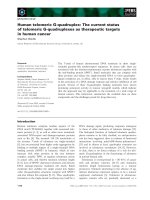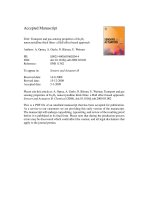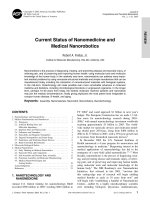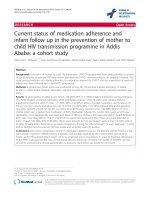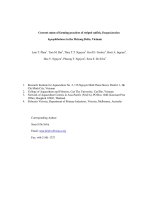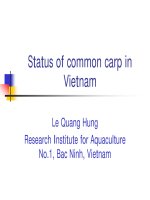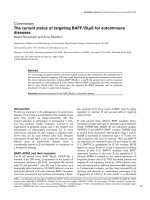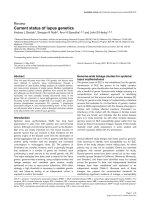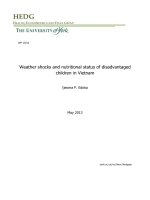GROUP ASSIGNMENT GROUP 6 MINERAL RESOURCES current status of mineral resource in the world and in vietnam
Bạn đang xem bản rút gọn của tài liệu. Xem và tải ngay bản đầy đủ của tài liệu tại đây (306.18 KB, 20 trang )
NATIONAL ECONOMICS UNIVERSITY
FACULTY OF REAL ESTATE AND RESOURCES ECONOMICS
***
GROUP ASSIGNMENT
GROUP 6: MINERAL RESOURCES
Hanoi, March 2022
TIEU LUAN MOI download :
Table of contents
Introduction
I.
Concepts and features
1.
Concepts
2.
Features
2.1. Features
2.2.
II.
Classification
Current status of mineral resource in the world and in Vietnam
1.
Current status in the
world Table 1.
2. Current status in
Vietnam Table 2.
III.
Case studies
1. In the world
1.1 Box 1: Myanmar: 2020 Hpakant jade mine disaster.
1.2 Box 2: EU paves way for renewable and low-carbon gases to replace
fossil fuel.
2. In Viet Nam
2.1 Box 3: Vietnam's kingdom of coal wants to use mining waste in
construction projects.
3.
Comments and solutions. Lessons learnt.
A. Comments and solution according to Case study 1
B. Comments and solution according to Case study 2
C. Comments and solution according to Case study 3
TIEU LUAN MOI download :
INTRODUCTION
A mineral resource is a concentration or occurrence of solid material of economic
interest in or on the Earth’s crust in such form, grade (or quality), and quantity that
there are reasonable prospects for eventual economic extraction. However, there are
several controversial issues about illegal exploitation in some cases. This essay will
help people gain more knowledge about this special resource, and relate it to the
current Vietnam status before particularly analyzing some real cases in the world.
TIEU LUAN MOI download :
I. CONCEPTS AND FEATURES
1. Concepts
Mineral resources are the accumulation of matter in the form of compounds
or elements in the earth's crust, which in current conditions humans are capable
of extracting useful elements or using them directly in life. It’s a kind of natural
resource, is a source of natural materials of inorganic or organic origin and
mostly located in the ground. The process of forming this type of resource is
closely related to the development history of the earth's crust over a long period
of thousands of years, sometimes millions of years.
2.
Features
2.1. Features
1. Mineral resources are nonrenewable resources. The process of mineral
formation is beyond human control and cannot be accelerated.
2. Mineral resources have a definite chemical composition. The composition of
chemical is unique in every other mineral.
3. The minerals whatever the type cannot be used directly. They become usable
only after they are processed and refined.
4. Minerals come from inorganic processes. That means there is no existence of
life in the formation of minerals.
5. Minerals are mostly found in solid forms with a definite international
structure.
TIEU LUAN MOI download :
Mineral resources are not endless, some types of reserves are small, so with the
development of modern industry, the depletion of mineral resources is a threat to
many countries.
Mineral resources are often concentrated in an area called a mineral deposit.
2.2.
Classification.
Depending on the characteristics and properties of each type of mineral, one
can classify them in many ways:
- By existence form: solid (copper, lead, iron...), gas (gas, helium, argon...) and
liquid form (oil, mineral water, ...)
- By origin: endogenous (igneous, or magmatic, in which minerals crystallize
from a melts) and exogenous (a process whose raw materials are particles from
other rocks that have undergone weathering or erosion)
- By chemical composition: metals (aluminum, iron, manganese, chromium...)
and non-metals (silicon, gypsum, seawater, groundwater...)
CURRENT STATUS OF MINERAL RESOURCES IN THE
WORLD
II.
1.
In the world
Minerals are not evenly distributed in the earth's crust. Mineral ores are found
in just a relatively few areas, because it takes a special set of circumstances to create
them.
Table 1. Leading countries worldwide based on natural
resource value as of 2021(in trillion U.S. dollars)
TIEU LUAN MOI download :
Country (main natural resources)
Russia (coal, natural gas, oil, gold, timber, rare earth metals)
United States (coal, timber, natural gas, gold, copper)
Saudi Arabia (oil, timber)
Canada (oil, uranium, timber, natural gas, phosphate)
Iran (oil, natural gas)*
China (coal, rare earth metals, timber)
Brazil (gold, uranium, iron, timber, oil)
Australia (coal, timber, copper, iron ore, gold, uranium)
Iraq (oil, phosphate rock)*
Venezuela (iron, natural gas, oil)
India (coal, bauxite, chromite, diamonds, limestone, natural gas,
titanium)
2. In Viet Nam
Vietnam is considered a country with diverse mineral resources with more
than 5000 mines of 60 types of minerals. In which, some species have important
reserves such as bauxite (672.1 million tons), apatite (0.778 million tons), titanium
(15.71 million tons), coal (3,520 million tons), rare earths (1. 1 million tons) and
granite (15 billion m3). Petroleum reserves are estimated at about 6 billion tons and
gas at about 4,000 billion m3, distributed mainly in sediments from the South to the
North.
Ion ore
Bauxite
Tin ore
TIEU LUAN MOI download :
Zinc ore
Copper Ore
Titan
According to the announcement in October 2014 of the US Geological Survey
(USGS): In 2012, Vietnam ranked 7th in crude oil production in the Asia Pacific
region (110 million gallon barrels); contributes 2.3% of the total world tin
production and 1.8% of the total cement production, 1% of the world total barite
production.
According to calculations, in the period 2008 - 2013, the contribution of the
mining industry to Vietnam's GDP increased from 9.07 % in 2008 to 11.49% in
2013, equivalent to 411,673 billion VND.
III.
1.
1.1.
CASE STUDIES ABOUT MINERAL MANAGEMENT.
In the world
Case study #1.
Box 1: Myanmar: 2020 Hpakant jade mine disaster.1
“…Myanmar’s worst mining disaster, in June last year rain began to saturate the
ground at the northern section of the Wai Khar open-pit jade mine in the region of
Hpakant. Eventually, on 2 July, a huge volume of quarry slope materials “collapsed
into a flooded open pit, burying and killing at least 172 jade miners”, write the
authors.
Although mining companies in Hpakant had been ordered by the authorities to
suspend operations from 1 July for three months for the monsoon season,
1 />
TIEU LUAN MOI download :
impoverished freelance scavengers were still hunting for unpicked jade exposed by
rain. Heavy rainfall was initially assumed to be the trigger for the collapse.
Myanmar’s National Human Rights Commission blamed the landslide on the
lack of due diligence and risk assessment from mining companies — at least 12 of
which owned licences covering specific parts of the Wai Khar mine at the time of
the accident. But non-governmental organizations say that a lack of regulatory
oversight from the government in the mining industry is also a major problem
endangering the lives of miners in Myanmar.
1.2.
Case study #2
Box 2: EU paves way for renewable and low-carbon gases to replace fossil fuel
The European Commission on Wednesday (15 December) unveiled a package of gas
legislation that aims to steer Europe away from fossil gas towards more sustainable
energy sources, like renewable and low-carbon hydrogen.
To reach its aim of net zero emissions by mid-century, Europe needs to drastically
increase the level of electrification across the economy, but the European
Commission says there will still be a need for gas in certain sectors that are difficult
to electrify, like heavy industry and transport.
“We know that electricity alone cannot deliver all the energy we’ll need in the future
and renewable and other low carbon gases will increasingly replace fossil fuels,” said
Frans Timmermans, the EU’s climate chief.
“Europe needs to turn the page on fossil fuels and move to cleaner energy sources.
This includes replacing fossil gas with renewable and low carbon gases, like
hydrogen,” he said.
TIEU LUAN MOI download :
According to the EU executive, gaseous fuels, like biogas, biomethane, renewable
and low-carbon hydrogen, as well as synthetic methane, will represent around a fifth
of final energy consumption by 2050.
“Electrification is a primary tool to implement renewable energy sources in all
sectors where this is technically and economically feasible. However, electrification
is not today at least possible in all sectors,” said a senior EU official who was
briefing the press on Tuesday (14 December).
“That is where we will continue to need gaseous fuels and, to meet our Green Deal
objectives,” the official continued, saying “these gaseous fuels, which today are
mainly fossil-based, need to be decarbonised”.
To enable the transition, the European Commission has introduced measures to
support renewable and low carbon gases, reduce methane emissions and
decarbonise buildings.
“The aim is to reduce the share of fossil gas in the mix by, on the one hand, energy
efficiency measures which reduce the overall consumption, but also then by
replacing it with these renewable and low carbon gases and electrification,” said an
EU official.
2. In Viet Nam
2.1
Case study #3
Box 3: Vietnam's kingdom of coal wants to use mining waste in construction
projects2
2 />
TIEU LUAN MOI download :
Quang Ninh Province, the biggest producer of coal in Vietnam, is proposing that
waste rock discarded in exploitation be used as material for the ground filling
process in construction projects.
Every year, coal mines in the northern province dump about 150 million cubic
meters of soil and rock, creating piled up hills on thousands of hectares of land in
Ha Long and Cam Pha towns.
This wasteland is close to residential areas, causing air pollution and posing the risk
of landslides, especially during the rainy season.
In a notable case, a storm in 2015 caused landslides at the waste dump owned by the
Coc Sau Coal JSC in Cam Pha Town, filling houses and land of people in the vicinity
with soil and rocks.
Now, the province’s authorities have thought of a solution.
Cao Tuong Huy, Quang Ninh’s deputy chairman, noted that as this waste piles up,
the demand for soil and rock to fill ground at many construction sites in the
province is high at around 130 million cubic meters per year.
Therefore, the province came up with a plan to use waste rocks discarded in the coal
mining process as ground filling materials for a five-year (2021-2025) period.
Hoang Cao Phuong, head of the Minerals Department under the ministry’s General
Department of Geology and Minerals of Vietnam, said the ingredients in the waste
rock from coal mines in Quang Ninh are mainly mineral substances commonly used
as building materials.
Therefore, the proposal of Quang Ninh Province to use it as ground filling material
for construction projects was reasonable.
TIEU LUAN MOI download :
While this policy was formulated since early this year, it is yet to be implemented
until now because of a number of obstacles, Huy said.
III.
Comments and solutions/ lesson learnt.
A. Case study #1: Myanmar: 2020 Hpakant jade mine disaster.
1.
Comments
- Lack of regulatory oversight from the government in the mining
industry
- These terrible consequences resulted from the poor design
and mismanagement.
- The mining site is under aggressive mining cycles that are exacerbated
by frequent, uncontrolled landslides
2.
-
Solutions
Training and Education: Safety training for both experienced and
new miners educate them about the risks of the mining occupation and
how to reduce them.
-
Wear Safety Equipment: Miners should be equipped with safety and
modern equipment, including helmets, lanyards, harnesses, gloves, safety
glasses, and gloves, among other protective gears.
-
Never Ignore an Impending Danger: It is undeniable that the mining
sector is innately filled with danger will mean that Employees must be alert
all the time and watching out for their colleagues as well.
-
Make use of Safety Mining Signs: Safety mining signs basically warn
people of any possible hazard and encourage employees to be careful at all
times + These signs should precisely state the message to avoid confusion
and they should be large enough to be read from a distance + these warning
TIEU LUAN MOI download :
signs should be put strategically in locations where accidents are most likely
to occur
B. Case study #2: EU paves way for renewable and low-carbon gases to
replace fossil fuel
1. Comments
- A sensible policy to reduce global warming emissions (one of the
main reasons leading to drought, sea-level rise, and extinction)
-
Improving public health: The air water pollution emitted by fossil fuels
and natural gas is linked with breathing problems, neurological damage,
heart attacks, cancer, premature death, and a host of other serious problems.
- Job and other economics benefits: Compared with fossil fuel
technologies, which are typically mechanized and capital intensive, the
renewable energy
industry is more labor intensive --> more jobs are created for each unit of
electricity generated from renewable sources than from fossil fuels.
2. Solutions
- Based on their policy, we should follow and renovate to fit with
our available resources.
-
Encouraging our nation to refer this policy.
C. Case study #3: Vietnam's kingdom of coal wants to use mining waste in
construction projects
1. Comments
-
Reducing environmental pollution: construction waste, water pollution.
-
Saving materials used for construction projects
-
Saving government budget.
2. Solutions
TIEU LUAN MOI download :
- Encourage both construction companies and state – owned
enterprises to follow this good policy.
- Vietnam government should have more policies to support these useful
ideas.
LIST OF REFERENCE
TIEU LUAN MOI download :
1. Deadly Myanmar mine disaster caused by poor planning, say data
sleuths
/>
2.
Vietnam's kingdom of coal wants to use mining waste in construction
projects
/>
3.
Leading countries worldwide based on natural resource value as of 2021(in
trillion U.S. dollars)
/>
4. EU paves way for renewable and low-carbon gases to replace fossil fuel
/>
replace-fossil-fuel/
5.
Viet Nam mineral resource’s reserve, mineral resources contribute to Viet
Nam’s GDP.
/>
TIEU LUAN MOI download :
